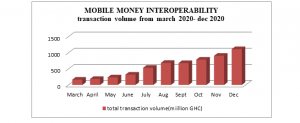Financial institutions in Ghana appreciate the fact that the future of financial services lies not with face-to-face interactions or brick and mortar structures but with appropriate technology solutions. Indeed, the pervasive use of technology in the financial sector has meant that the losers are the ones who do not use technology.
Unless institutions in this sector adapt to technology and adopt the latest tools and software, they are bound to perish in the uber-competitive market landscape. The Ghanaian economy revolves around finance and financial activities which are predominantly undertaken by the banking sector.
The Traditional System; Bank branches form the traditional channel for delivery of banking services. A number of banks in the economy have branches although off late banks have reduced the reliance on these branches and are attempting to replace expensive branches with inexpensive technologies. However, for the moment, branches still remain one of the most popular methods of delivering banking services because they enable banks to offer all services from the same location.
The Modern Delivery Formats; The modern service delivery formats vary significantly from the branch-based model. Firstly, the focus is on efficiency. The deployment of technology has made huge strides by allowing banks to provide much better levels of service to their customers at drastically lower costs.
If a company wants to succeed and remain relevant, it must focus on meeting customer demand through growing and evolving the customer experience journey digitally to compliment the physical.
Digitization and innovation are rapidly changing the face of banking in Ghana. Perhaps, it can be said that in recent years the whole concept of banking has undergone changes and it is not yet over. Here is a list of some recent developments in Ghana
Mobile Money Interoperability System; this is aimed at eliminating the complexities and inconveniences associated with transfers across the various mobile money networks. Furthermore, it ropes in mobile money users into the financial ecosystem of Ghana. With the launch of the Mobile Money Interoperability System, customers are able to transfer funds from one mobile money wallet to another wallet across networks.

Source; BoG Summary of Economic and Financial Data January 2021
The use of mobile money has witnessed exponential growth over past years; with a year on year increase in the number of mobile money accounts as well as the volumes and value of mobile money transactions.
From the diagram above, the total transaction volume increased from 166.3 million in March 2020 to 1112.2 million in December 2020. This system has further deepened financial inclusion and promotes many cashless transactions in Ghana.
Universal Quick Response (QR) Code: This was launched to help customers make payments to merchants from multiple funding sources like mobile wallets, cards or bank accounts.
Unlike unique QR codes for electronic payments, being universal means that allows customers to make Instant payments for goods and services from different funding sources (mobile wallets, cards, bank accounts) by scanning a quick response code on a phone. Both the smart and non-smart phones users can make payment through this QR codes.

This Mobile application has been developed to enable customers to obtain all the services that they would be able to avail at a branch. Once again, the threats of security attacks and hacking are present. However, these are risks that are being mitigated.
POS System and Mobile Apps: Point of Sale (POS) terminals scan a magnetically encoded card (debit/credit card) to enable a fund transfer from the customer to the business. These enable a customer to electronically debit a certain amount from his account and credit it to the business’ account.
However, the scope of Point of Sales (POS) is expanding as these services are now available on various mobile platforms via the internet. According to BoG (2021 report), POS Payment Terminals deployed has increased from 9615 in April 2020 to 12011 as at April 2021.
With the introduction of mobile apps, your days of visiting the bank branch to make a deposit are over as customers can send money directly to MTN mobile money, Vodafone Cash or to a bank account. Expresspay, Zeepay, EziPay, PayPal, Express pay, and other such e-wallets are becoming increasingly common, especially as the government is encouraging cashless transactions.
Although the recent developments with digital transformation has been a game changer for the financial services sectors, digital transformations are lagging or even failing for several reasons.
Culture shock; Human development takes place in the context of complex networks that influence each other. But digital transformation doesn’t have to disable a company’s operations even though it can be difficult on people in any organization. Changing the business culture that an organization has long inherited is equal to starting a company from its initial brick.
The inability of individuals to adjust to society and culture can cause anxiety, discomfort, and tension. For many financial institutions, the culture change required for transformation can prove insurmountable.
For most financial institutions, their organizational structure is not aligned to support transformation thus, realizing how to optimize its potential is complicated,” “That narrow mindset — lacking a common vision and failing to consider the entire ecosystem — is exactly where digital initiatives go wrong. The ability to digitally reimagine the business is determined in large part by a clear digital strategy supported by leaders who foster a culture able to change and invent the new.
Talent deficit: Digital transformations require new talent, including personnel trained in the latest programming languages and product managers who know what customers want in a virtual assistant but financial institutions approach to attracting and retaining talent cannot be classified as strategic and optimized.
Specifically, this is due to a lack of ability in identifying potential internal candidates; a lack of assurance, confidence and skills in tackling global sourcing; and concerns that financial institutions branding would help them secure the necessary quality of talent.
A strategic plan to address priority pain points is required to build a talent pipeline for the future. Organizations in Ghana need extensive talent structure changes for their digital transformation efforts to be successful.
Trouble with ‘what and how’; a major stumbling block for digital transformations involves the failure to understand the technology required and the talent necessary to operate it. Still, most financial institutions struggle to figure out what they need to change and how to go about it.
This indecision can create inertia or, worse, wrong decisions. Does a financial institution need a new operating model for digital? How many Scrum/agile experts does this require? The pace of digital change makes this a difficult but necessary ingredient for success.
To conclude, the adoption of digitalization specifically within the financial sector is not always an easy thing to bring about as it can be complex and expensive to implement but financial institutions need to re-examine their service and delivery systems in order to properly position them within the framework of the dictates of the dynamism of Information and Communication Technology.
Additionally, the powers that technology offers can be misused and abused either out of ignorance or willful blindness. Thus, it is clear that there must be a responsible use of technology and as long as one takes the position that Technology is Value Neutral and the humans using it have to do so with caution, it is clear that such technologies can be a force for good and would continue to drive human progress.
The author is a researcher/consultant. Contact: [email protected], Cell: +233 54 347 5499










